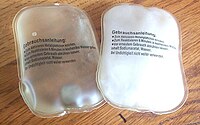
Photo from wikipedia
To meet the requirement of big data era and neuromorphic computations, nonvolatile memory with fast speed, high density, and low power consumption is urgently needed. As an emerging technology, phase-change… Click to show full abstract
To meet the requirement of big data era and neuromorphic computations, nonvolatile memory with fast speed, high density, and low power consumption is urgently needed. As an emerging technology, phase-change memory is a promising candidate to solve this problem. However, the drawback of the high power consumption hinders their applications. Most recently, a new phase-change material of [(GeTe)x/(Sb2Te3)y]n superlattice attracts intensive attentions owing to its ultralow power consumption comparing with conventional phase-change memory devices. Many studies on this new material have been reported. However, there still lacks a comprehensive and unified understanding of its atomic picture and working mechanism. This article at first summarizes the broad applications for phase-change materials. Then, the major progresses of phase-change superlattices to understand the microscopic structure and working principles for data storage are discussed. Strategies on material optimizations to further enhance device performances are proposed. Finally, an outlook on new applications with these advanced superlattice materials is suggested.
Journal Title: Advanced Functional Materials
Year Published: 2018
Link to full text (if available)
Share on Social Media: Sign Up to like & get
recommendations!